Toyota: Analysis of Leadership and Management in Operations
VerifiedAdded on 2021/01/03
|17
|5354
|79
Report
AI Summary
This report provides an in-depth analysis of leadership and management within the Toyota Motor Corporation. It begins with an overview of Toyota's management structure, including its global hierarchy, geographic divisions, and product-based divisions. The report then defines and compares the roles and characteristics of leaders and managers, highlighting the differences in their approaches and responsibilities. The analysis extends to the application of various leadership and management theories, such as contingency theory and situational leadership, in different contexts. The report further explores the strengths and weaknesses of different management and leadership approaches, providing examples of how these approaches are implemented within Toyota. It also examines key approaches to operations management and the roles of leaders and managers in achieving business objectives, as well as factors within the business environment that impact operational management and decision-making. Finally, the report concludes with a critical evaluation of the application of operations management and the factors that impact the wider business environment.
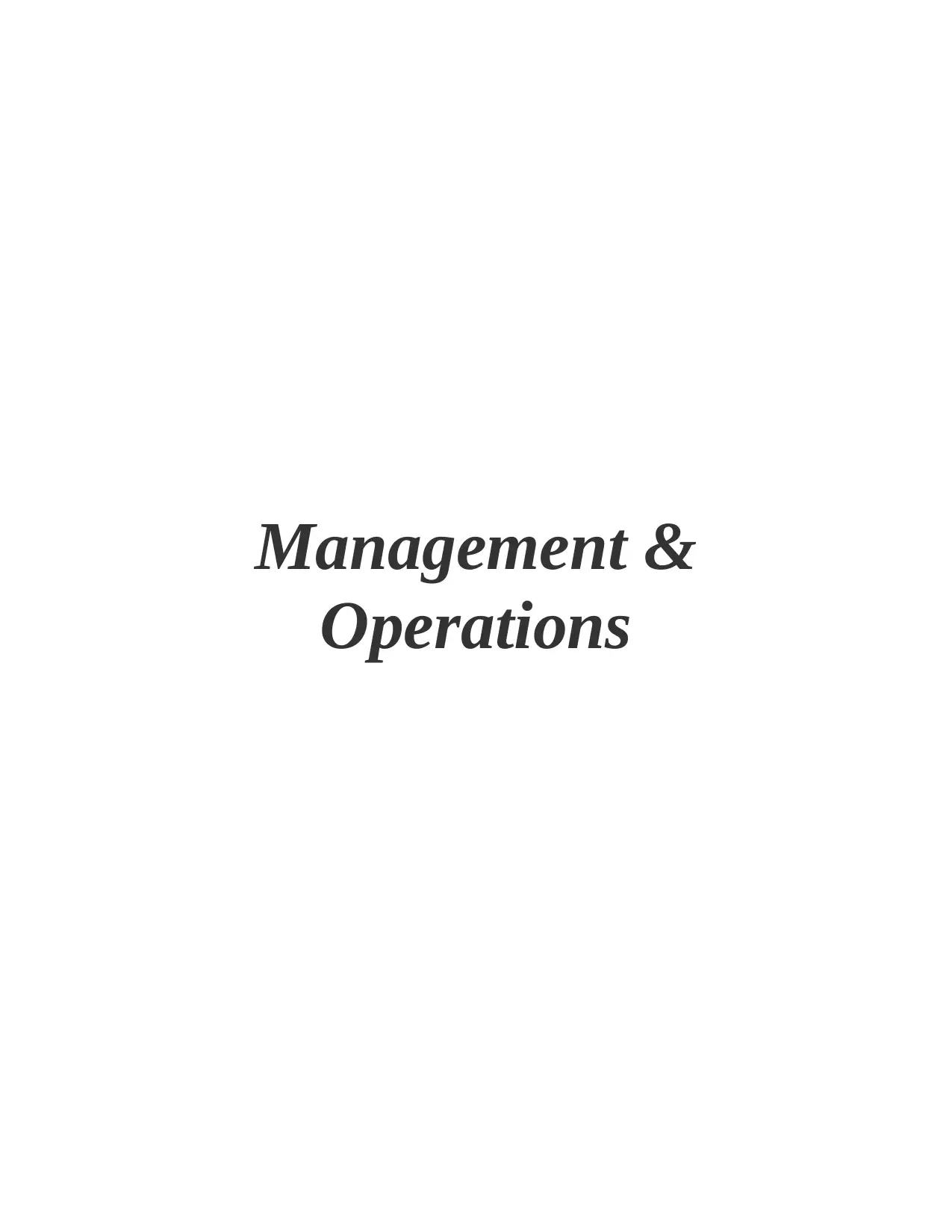
Management &
Operations
Operations
Paraphrase This Document
Need a fresh take? Get an instant paraphrase of this document with our AI Paraphraser
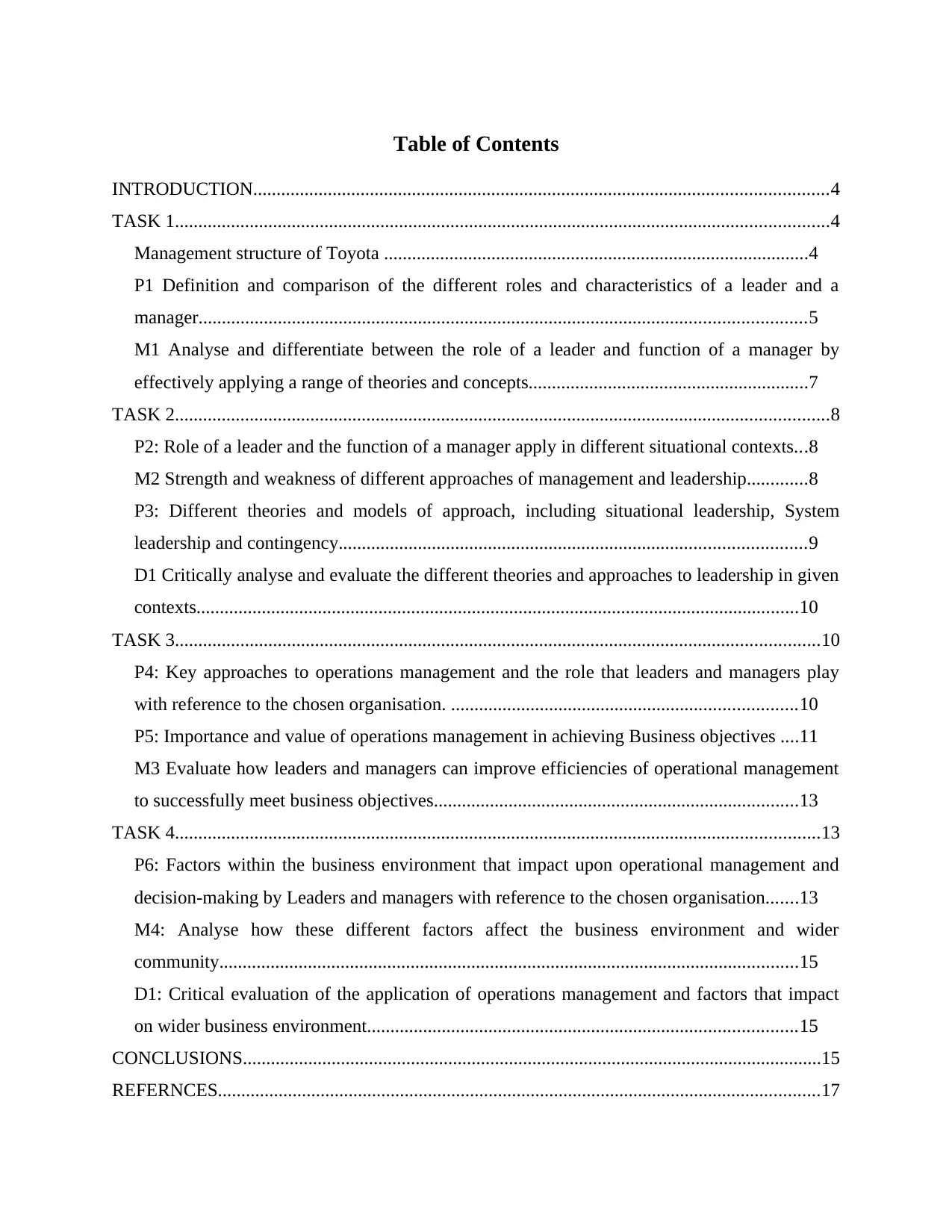
Table of Contents
INTRODUCTION...........................................................................................................................4
TASK 1............................................................................................................................................4
Management structure of Toyota ...........................................................................................4
P1 Definition and comparison of the different roles and characteristics of a leader and a
manager..................................................................................................................................5
M1 Analyse and differentiate between the role of a leader and function of a manager by
effectively applying a range of theories and concepts............................................................7
TASK 2............................................................................................................................................8
P2: Role of a leader and the function of a manager apply in different situational contexts...8
M2 Strength and weakness of different approaches of management and leadership.............8
P3: Different theories and models of approach, including situational leadership, System
leadership and contingency....................................................................................................9
D1 Critically analyse and evaluate the different theories and approaches to leadership in given
contexts.................................................................................................................................10
TASK 3..........................................................................................................................................10
P4: Key approaches to operations management and the role that leaders and managers play
with reference to the chosen organisation. ..........................................................................10
P5: Importance and value of operations management in achieving Business objectives ....11
M3 Evaluate how leaders and managers can improve efficiencies of operational management
to successfully meet business objectives..............................................................................13
TASK 4..........................................................................................................................................13
P6: Factors within the business environment that impact upon operational management and
decision-making by Leaders and managers with reference to the chosen organisation.......13
M4: Analyse how these different factors affect the business environment and wider
community............................................................................................................................15
D1: Critical evaluation of the application of operations management and factors that impact
on wider business environment............................................................................................15
CONCLUSIONS............................................................................................................................15
REFERNCES.................................................................................................................................17
INTRODUCTION...........................................................................................................................4
TASK 1............................................................................................................................................4
Management structure of Toyota ...........................................................................................4
P1 Definition and comparison of the different roles and characteristics of a leader and a
manager..................................................................................................................................5
M1 Analyse and differentiate between the role of a leader and function of a manager by
effectively applying a range of theories and concepts............................................................7
TASK 2............................................................................................................................................8
P2: Role of a leader and the function of a manager apply in different situational contexts...8
M2 Strength and weakness of different approaches of management and leadership.............8
P3: Different theories and models of approach, including situational leadership, System
leadership and contingency....................................................................................................9
D1 Critically analyse and evaluate the different theories and approaches to leadership in given
contexts.................................................................................................................................10
TASK 3..........................................................................................................................................10
P4: Key approaches to operations management and the role that leaders and managers play
with reference to the chosen organisation. ..........................................................................10
P5: Importance and value of operations management in achieving Business objectives ....11
M3 Evaluate how leaders and managers can improve efficiencies of operational management
to successfully meet business objectives..............................................................................13
TASK 4..........................................................................................................................................13
P6: Factors within the business environment that impact upon operational management and
decision-making by Leaders and managers with reference to the chosen organisation.......13
M4: Analyse how these different factors affect the business environment and wider
community............................................................................................................................15
D1: Critical evaluation of the application of operations management and factors that impact
on wider business environment............................................................................................15
CONCLUSIONS............................................................................................................................15
REFERNCES.................................................................................................................................17

⊘ This is a preview!⊘
Do you want full access?
Subscribe today to unlock all pages.

Trusted by 1+ million students worldwide
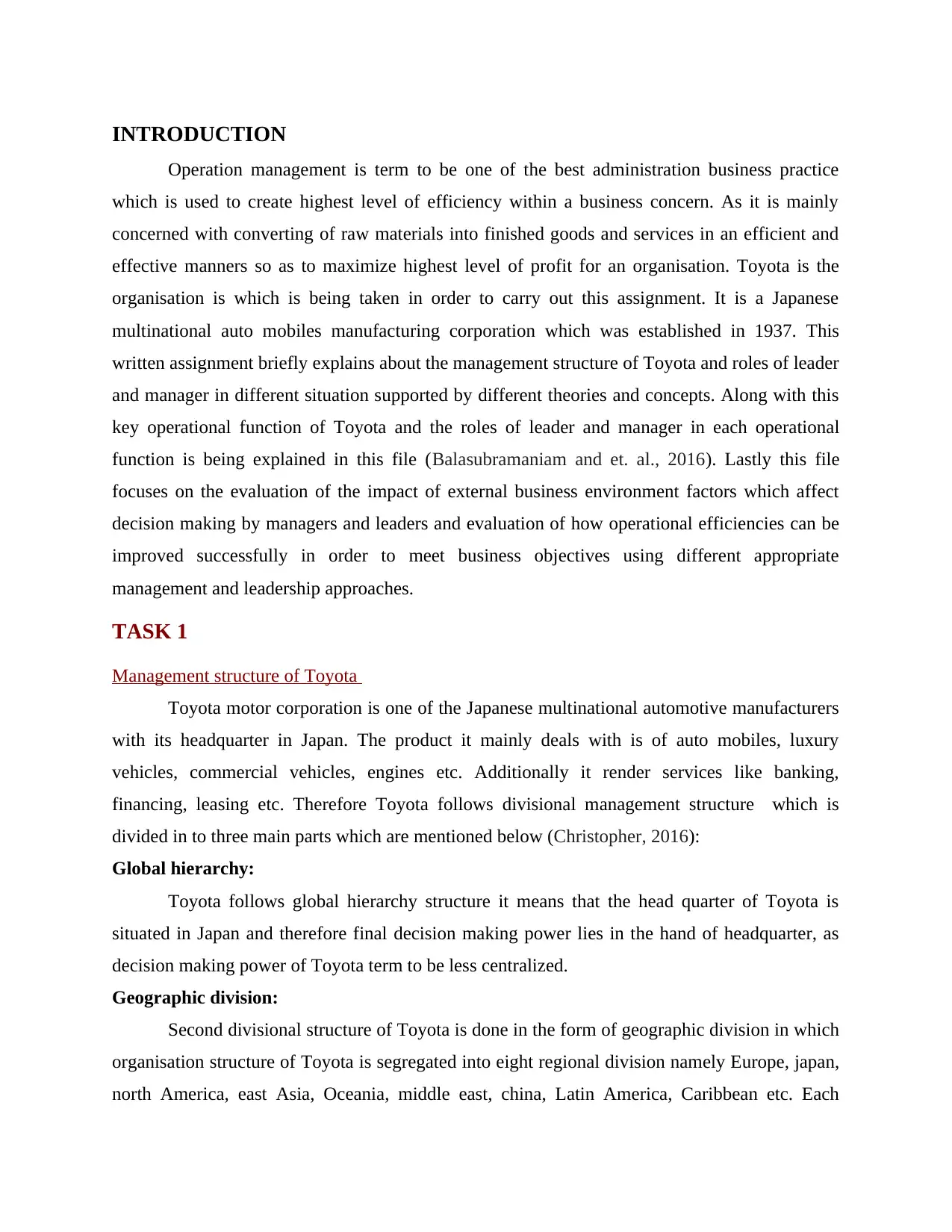
INTRODUCTION
Operation management is term to be one of the best administration business practice
which is used to create highest level of efficiency within a business concern. As it is mainly
concerned with converting of raw materials into finished goods and services in an efficient and
effective manners so as to maximize highest level of profit for an organisation. Toyota is the
organisation is which is being taken in order to carry out this assignment. It is a Japanese
multinational auto mobiles manufacturing corporation which was established in 1937. This
written assignment briefly explains about the management structure of Toyota and roles of leader
and manager in different situation supported by different theories and concepts. Along with this
key operational function of Toyota and the roles of leader and manager in each operational
function is being explained in this file (Balasubramaniam and et. al., 2016). Lastly this file
focuses on the evaluation of the impact of external business environment factors which affect
decision making by managers and leaders and evaluation of how operational efficiencies can be
improved successfully in order to meet business objectives using different appropriate
management and leadership approaches.
TASK 1
Management structure of Toyota
Toyota motor corporation is one of the Japanese multinational automotive manufacturers
with its headquarter in Japan. The product it mainly deals with is of auto mobiles, luxury
vehicles, commercial vehicles, engines etc. Additionally it render services like banking,
financing, leasing etc. Therefore Toyota follows divisional management structure which is
divided in to three main parts which are mentioned below (Christopher, 2016):
Global hierarchy:
Toyota follows global hierarchy structure it means that the head quarter of Toyota is
situated in Japan and therefore final decision making power lies in the hand of headquarter, as
decision making power of Toyota term to be less centralized.
Geographic division:
Second divisional structure of Toyota is done in the form of geographic division in which
organisation structure of Toyota is segregated into eight regional division namely Europe, japan,
north America, east Asia, Oceania, middle east, china, Latin America, Caribbean etc. Each
Operation management is term to be one of the best administration business practice
which is used to create highest level of efficiency within a business concern. As it is mainly
concerned with converting of raw materials into finished goods and services in an efficient and
effective manners so as to maximize highest level of profit for an organisation. Toyota is the
organisation is which is being taken in order to carry out this assignment. It is a Japanese
multinational auto mobiles manufacturing corporation which was established in 1937. This
written assignment briefly explains about the management structure of Toyota and roles of leader
and manager in different situation supported by different theories and concepts. Along with this
key operational function of Toyota and the roles of leader and manager in each operational
function is being explained in this file (Balasubramaniam and et. al., 2016). Lastly this file
focuses on the evaluation of the impact of external business environment factors which affect
decision making by managers and leaders and evaluation of how operational efficiencies can be
improved successfully in order to meet business objectives using different appropriate
management and leadership approaches.
TASK 1
Management structure of Toyota
Toyota motor corporation is one of the Japanese multinational automotive manufacturers
with its headquarter in Japan. The product it mainly deals with is of auto mobiles, luxury
vehicles, commercial vehicles, engines etc. Additionally it render services like banking,
financing, leasing etc. Therefore Toyota follows divisional management structure which is
divided in to three main parts which are mentioned below (Christopher, 2016):
Global hierarchy:
Toyota follows global hierarchy structure it means that the head quarter of Toyota is
situated in Japan and therefore final decision making power lies in the hand of headquarter, as
decision making power of Toyota term to be less centralized.
Geographic division:
Second divisional structure of Toyota is done in the form of geographic division in which
organisation structure of Toyota is segregated into eight regional division namely Europe, japan,
north America, east Asia, Oceania, middle east, china, Latin America, Caribbean etc. Each
Paraphrase This Document
Need a fresh take? Get an instant paraphrase of this document with our AI Paraphraser
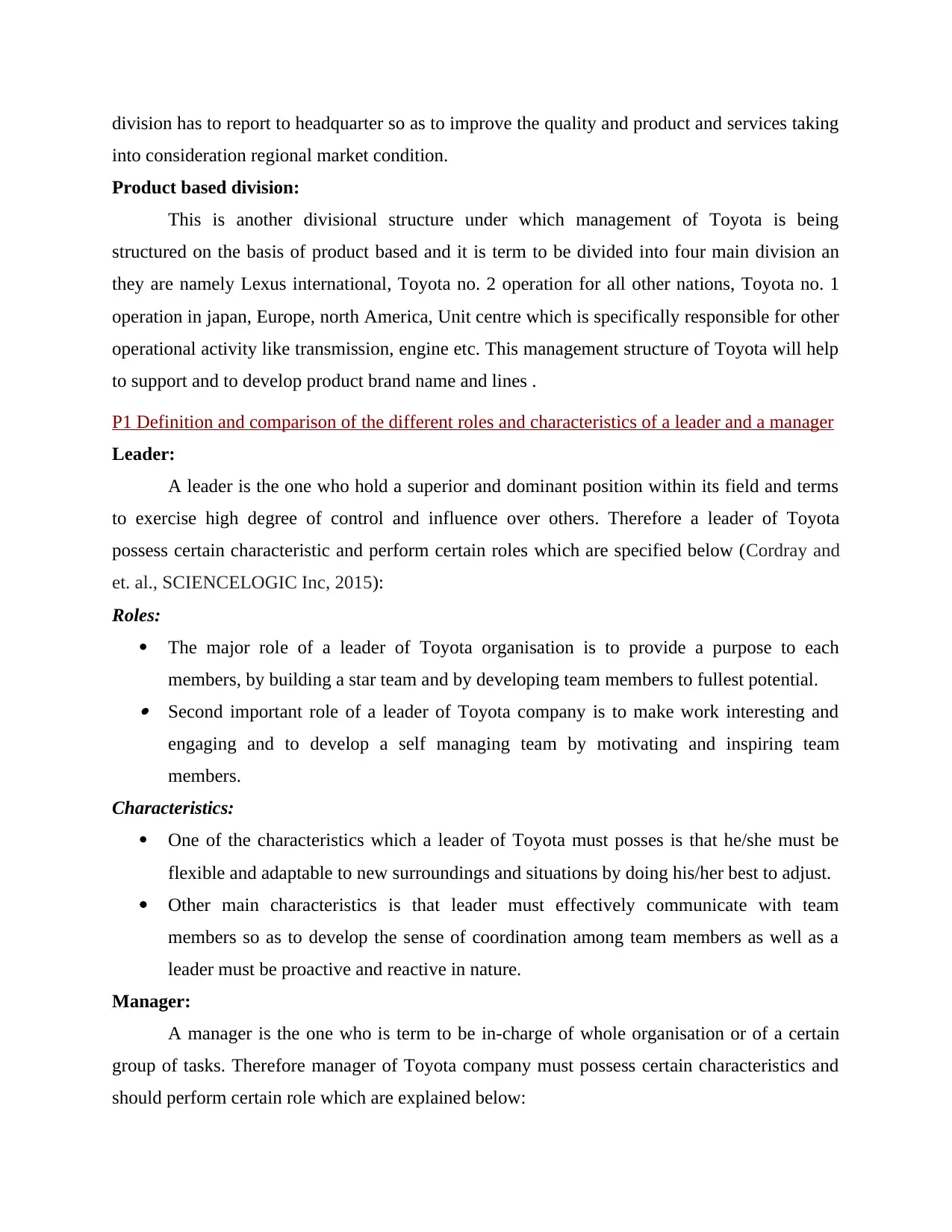
division has to report to headquarter so as to improve the quality and product and services taking
into consideration regional market condition.
Product based division:
This is another divisional structure under which management of Toyota is being
structured on the basis of product based and it is term to be divided into four main division an
they are namely Lexus international, Toyota no. 2 operation for all other nations, Toyota no. 1
operation in japan, Europe, north America, Unit centre which is specifically responsible for other
operational activity like transmission, engine etc. This management structure of Toyota will help
to support and to develop product brand name and lines .
P1 Definition and comparison of the different roles and characteristics of a leader and a manager
Leader:
A leader is the one who hold a superior and dominant position within its field and terms
to exercise high degree of control and influence over others. Therefore a leader of Toyota
possess certain characteristic and perform certain roles which are specified below (Cordray and
et. al., SCIENCELOGIC Inc, 2015):
Roles:
The major role of a leader of Toyota organisation is to provide a purpose to each
members, by building a star team and by developing team members to fullest potential. Second important role of a leader of Toyota company is to make work interesting and
engaging and to develop a self managing team by motivating and inspiring team
members.
Characteristics:
One of the characteristics which a leader of Toyota must posses is that he/she must be
flexible and adaptable to new surroundings and situations by doing his/her best to adjust.
Other main characteristics is that leader must effectively communicate with team
members so as to develop the sense of coordination among team members as well as a
leader must be proactive and reactive in nature.
Manager:
A manager is the one who is term to be in-charge of whole organisation or of a certain
group of tasks. Therefore manager of Toyota company must possess certain characteristics and
should perform certain role which are explained below:
into consideration regional market condition.
Product based division:
This is another divisional structure under which management of Toyota is being
structured on the basis of product based and it is term to be divided into four main division an
they are namely Lexus international, Toyota no. 2 operation for all other nations, Toyota no. 1
operation in japan, Europe, north America, Unit centre which is specifically responsible for other
operational activity like transmission, engine etc. This management structure of Toyota will help
to support and to develop product brand name and lines .
P1 Definition and comparison of the different roles and characteristics of a leader and a manager
Leader:
A leader is the one who hold a superior and dominant position within its field and terms
to exercise high degree of control and influence over others. Therefore a leader of Toyota
possess certain characteristic and perform certain roles which are specified below (Cordray and
et. al., SCIENCELOGIC Inc, 2015):
Roles:
The major role of a leader of Toyota organisation is to provide a purpose to each
members, by building a star team and by developing team members to fullest potential. Second important role of a leader of Toyota company is to make work interesting and
engaging and to develop a self managing team by motivating and inspiring team
members.
Characteristics:
One of the characteristics which a leader of Toyota must posses is that he/she must be
flexible and adaptable to new surroundings and situations by doing his/her best to adjust.
Other main characteristics is that leader must effectively communicate with team
members so as to develop the sense of coordination among team members as well as a
leader must be proactive and reactive in nature.
Manager:
A manager is the one who is term to be in-charge of whole organisation or of a certain
group of tasks. Therefore manager of Toyota company must possess certain characteristics and
should perform certain role which are explained below:
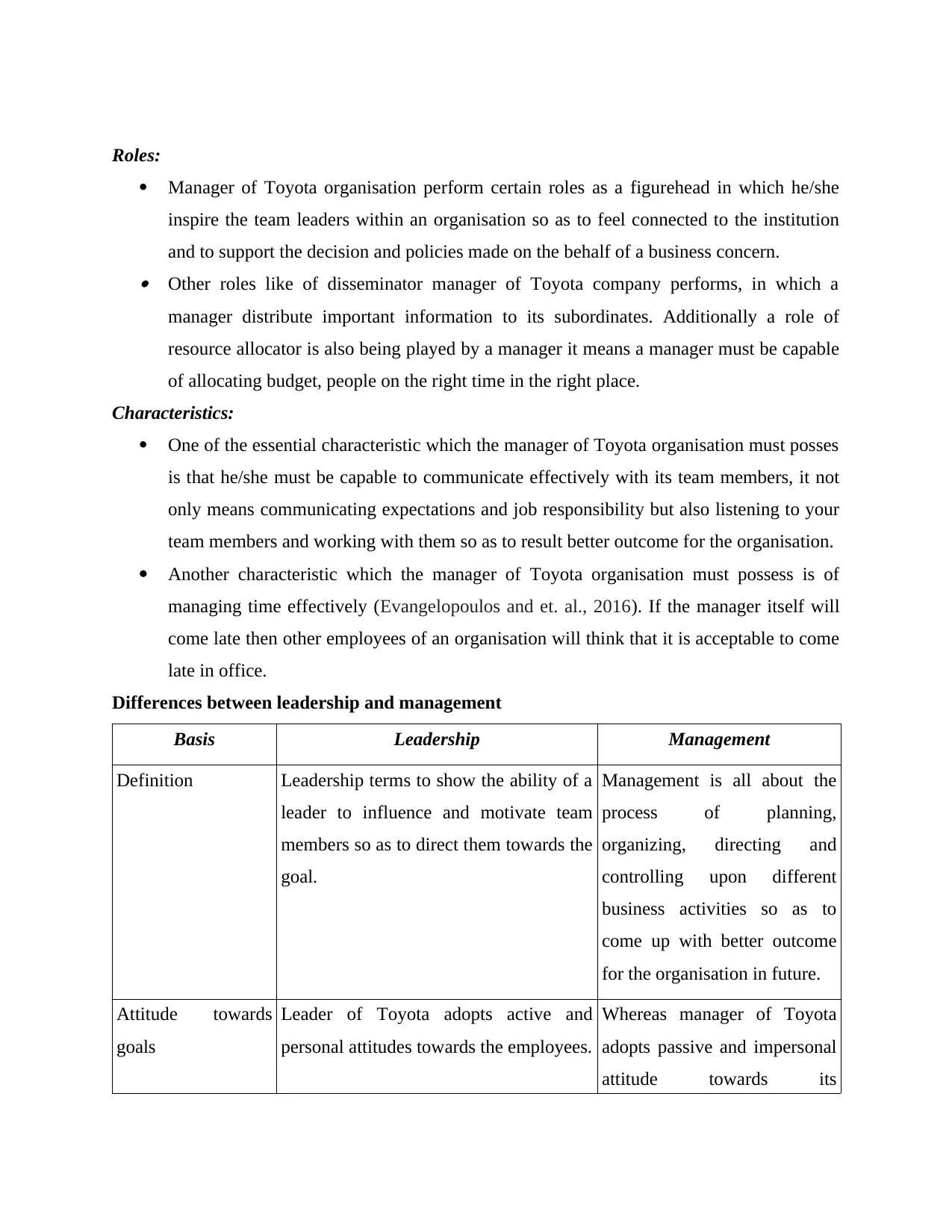
Roles:
Manager of Toyota organisation perform certain roles as a figurehead in which he/she
inspire the team leaders within an organisation so as to feel connected to the institution
and to support the decision and policies made on the behalf of a business concern. Other roles like of disseminator manager of Toyota company performs, in which a
manager distribute important information to its subordinates. Additionally a role of
resource allocator is also being played by a manager it means a manager must be capable
of allocating budget, people on the right time in the right place.
Characteristics:
One of the essential characteristic which the manager of Toyota organisation must posses
is that he/she must be capable to communicate effectively with its team members, it not
only means communicating expectations and job responsibility but also listening to your
team members and working with them so as to result better outcome for the organisation.
Another characteristic which the manager of Toyota organisation must possess is of
managing time effectively (Evangelopoulos and et. al., 2016). If the manager itself will
come late then other employees of an organisation will think that it is acceptable to come
late in office.
Differences between leadership and management
Basis Leadership Management
Definition Leadership terms to show the ability of a
leader to influence and motivate team
members so as to direct them towards the
goal.
Management is all about the
process of planning,
organizing, directing and
controlling upon different
business activities so as to
come up with better outcome
for the organisation in future.
Attitude towards
goals
Leader of Toyota adopts active and
personal attitudes towards the employees.
Whereas manager of Toyota
adopts passive and impersonal
attitude towards its
Manager of Toyota organisation perform certain roles as a figurehead in which he/she
inspire the team leaders within an organisation so as to feel connected to the institution
and to support the decision and policies made on the behalf of a business concern. Other roles like of disseminator manager of Toyota company performs, in which a
manager distribute important information to its subordinates. Additionally a role of
resource allocator is also being played by a manager it means a manager must be capable
of allocating budget, people on the right time in the right place.
Characteristics:
One of the essential characteristic which the manager of Toyota organisation must posses
is that he/she must be capable to communicate effectively with its team members, it not
only means communicating expectations and job responsibility but also listening to your
team members and working with them so as to result better outcome for the organisation.
Another characteristic which the manager of Toyota organisation must possess is of
managing time effectively (Evangelopoulos and et. al., 2016). If the manager itself will
come late then other employees of an organisation will think that it is acceptable to come
late in office.
Differences between leadership and management
Basis Leadership Management
Definition Leadership terms to show the ability of a
leader to influence and motivate team
members so as to direct them towards the
goal.
Management is all about the
process of planning,
organizing, directing and
controlling upon different
business activities so as to
come up with better outcome
for the organisation in future.
Attitude towards
goals
Leader of Toyota adopts active and
personal attitudes towards the employees.
Whereas manager of Toyota
adopts passive and impersonal
attitude towards its
⊘ This is a preview!⊘
Do you want full access?
Subscribe today to unlock all pages.

Trusted by 1+ million students worldwide
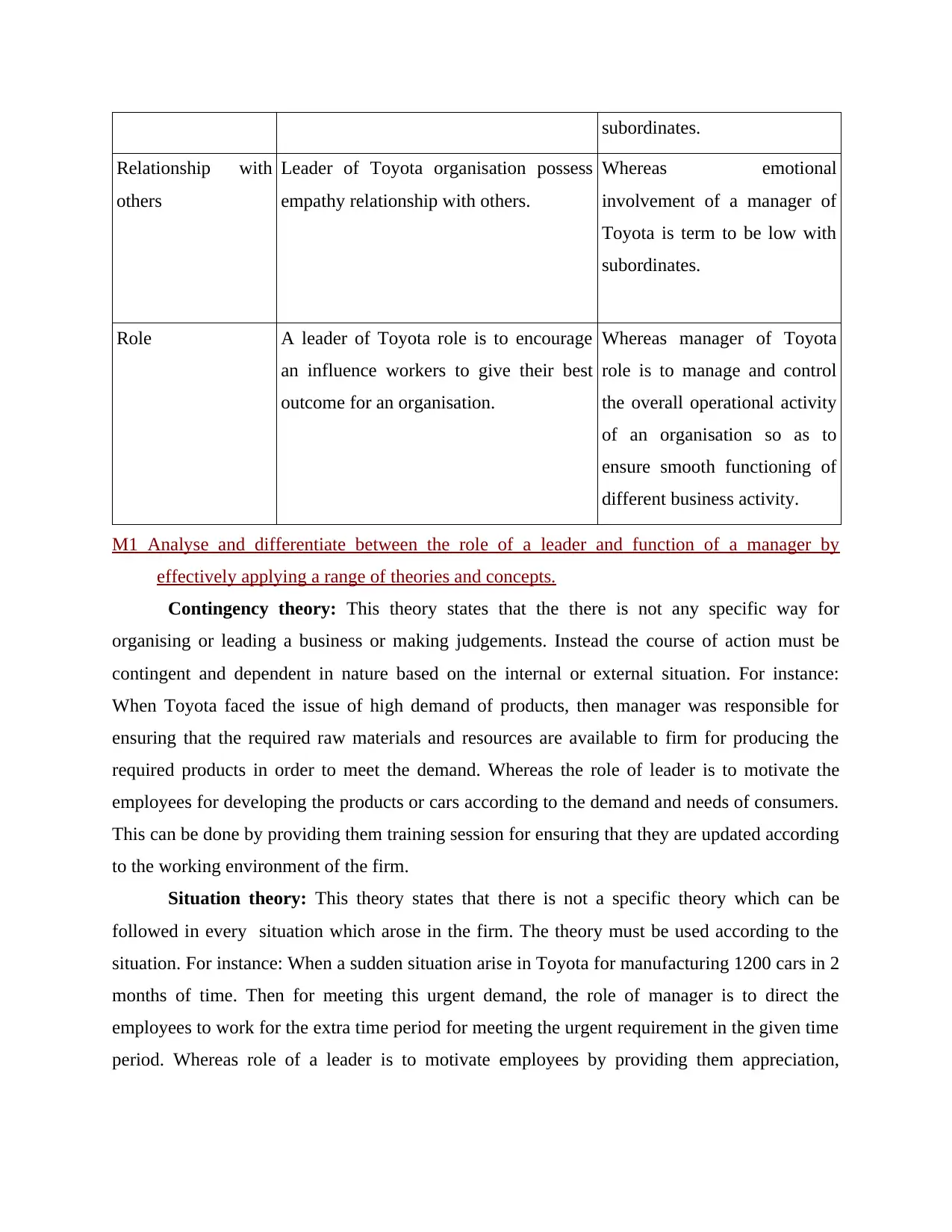
subordinates.
Relationship with
others
Leader of Toyota organisation possess
empathy relationship with others.
Whereas emotional
involvement of a manager of
Toyota is term to be low with
subordinates.
Role A leader of Toyota role is to encourage
an influence workers to give their best
outcome for an organisation.
Whereas manager of Toyota
role is to manage and control
the overall operational activity
of an organisation so as to
ensure smooth functioning of
different business activity.
M1 Analyse and differentiate between the role of a leader and function of a manager by
effectively applying a range of theories and concepts.
Contingency theory: This theory states that the there is not any specific way for
organising or leading a business or making judgements. Instead the course of action must be
contingent and dependent in nature based on the internal or external situation. For instance:
When Toyota faced the issue of high demand of products, then manager was responsible for
ensuring that the required raw materials and resources are available to firm for producing the
required products in order to meet the demand. Whereas the role of leader is to motivate the
employees for developing the products or cars according to the demand and needs of consumers.
This can be done by providing them training session for ensuring that they are updated according
to the working environment of the firm.
Situation theory: This theory states that there is not a specific theory which can be
followed in every situation which arose in the firm. The theory must be used according to the
situation. For instance: When a sudden situation arise in Toyota for manufacturing 1200 cars in 2
months of time. Then for meeting this urgent demand, the role of manager is to direct the
employees to work for the extra time period for meeting the urgent requirement in the given time
period. Whereas role of a leader is to motivate employees by providing them appreciation,
Relationship with
others
Leader of Toyota organisation possess
empathy relationship with others.
Whereas emotional
involvement of a manager of
Toyota is term to be low with
subordinates.
Role A leader of Toyota role is to encourage
an influence workers to give their best
outcome for an organisation.
Whereas manager of Toyota
role is to manage and control
the overall operational activity
of an organisation so as to
ensure smooth functioning of
different business activity.
M1 Analyse and differentiate between the role of a leader and function of a manager by
effectively applying a range of theories and concepts.
Contingency theory: This theory states that the there is not any specific way for
organising or leading a business or making judgements. Instead the course of action must be
contingent and dependent in nature based on the internal or external situation. For instance:
When Toyota faced the issue of high demand of products, then manager was responsible for
ensuring that the required raw materials and resources are available to firm for producing the
required products in order to meet the demand. Whereas the role of leader is to motivate the
employees for developing the products or cars according to the demand and needs of consumers.
This can be done by providing them training session for ensuring that they are updated according
to the working environment of the firm.
Situation theory: This theory states that there is not a specific theory which can be
followed in every situation which arose in the firm. The theory must be used according to the
situation. For instance: When a sudden situation arise in Toyota for manufacturing 1200 cars in 2
months of time. Then for meeting this urgent demand, the role of manager is to direct the
employees to work for the extra time period for meeting the urgent requirement in the given time
period. Whereas role of a leader is to motivate employees by providing them appreciation,
Paraphrase This Document
Need a fresh take? Get an instant paraphrase of this document with our AI Paraphraser

incentives, rewards etc. Through this, the employees stay motivated and encouraged in their
working for fulfilling the urgent requirement of 1200 cars in 2 months.
TASK 2
P2: Role of a leader and the function of a manager apply in different situational contexts.
Any situation in an organisation doe not stay stable and various changes take place in the
situation. Leaders and managers plays a crucial role in effectively dealing with such situations by
using some theories and concepts. Some of these theories are discussed below (Mahadevan,
2015):
First situation may take place when Toyota faced the issue of high demand of products,
then manager was responsible for ensuring that the required raw materials and resources are
available to firm for producing the required products in order to meet the demand. Whereas the
role of leader is to motivate the employees for developing the products or cars according to the
demand and needs of consumers. This can be done by providing them training session for
ensuring that they are updated according to the working environment of the firm.
Second situation may take place when a sudden situation arise in Toyota for
manufacturing 1200 cars in 2 months of time. Then for meeting this urgent demand, the role of
manager is to direct the employees to work for the extra time period for meeting the urgent
requirement in the given time period. Whereas role of a leader is to motivate employees by
providing them appreciation, incentives, rewards etc. Through this, the employees stay motivated
and encouraged in their working for fulfilling the urgent requirement of 1200 cars in 2 months.
M2 Strength and weakness of different approaches of management and leadership
There are different types of approaches of management and leadership which will be
explained below by taking Toyota as a functional examples,
Situational leadership: This is one of the most effective style in which leader changes
and adjust their leadership styles according to the situations company is facing. For instance, if
Toyota have to take fast decision to remove the obstacle then leader will opt autocratic styles and
when company is planning to bring changes then leader will opt democratic style and take
opinions of employees before finalising any one decision. Advantages and disadvantage of
situational leadership style is given below,
working for fulfilling the urgent requirement of 1200 cars in 2 months.
TASK 2
P2: Role of a leader and the function of a manager apply in different situational contexts.
Any situation in an organisation doe not stay stable and various changes take place in the
situation. Leaders and managers plays a crucial role in effectively dealing with such situations by
using some theories and concepts. Some of these theories are discussed below (Mahadevan,
2015):
First situation may take place when Toyota faced the issue of high demand of products,
then manager was responsible for ensuring that the required raw materials and resources are
available to firm for producing the required products in order to meet the demand. Whereas the
role of leader is to motivate the employees for developing the products or cars according to the
demand and needs of consumers. This can be done by providing them training session for
ensuring that they are updated according to the working environment of the firm.
Second situation may take place when a sudden situation arise in Toyota for
manufacturing 1200 cars in 2 months of time. Then for meeting this urgent demand, the role of
manager is to direct the employees to work for the extra time period for meeting the urgent
requirement in the given time period. Whereas role of a leader is to motivate employees by
providing them appreciation, incentives, rewards etc. Through this, the employees stay motivated
and encouraged in their working for fulfilling the urgent requirement of 1200 cars in 2 months.
M2 Strength and weakness of different approaches of management and leadership
There are different types of approaches of management and leadership which will be
explained below by taking Toyota as a functional examples,
Situational leadership: This is one of the most effective style in which leader changes
and adjust their leadership styles according to the situations company is facing. For instance, if
Toyota have to take fast decision to remove the obstacle then leader will opt autocratic styles and
when company is planning to bring changes then leader will opt democratic style and take
opinions of employees before finalising any one decision. Advantages and disadvantage of
situational leadership style is given below,
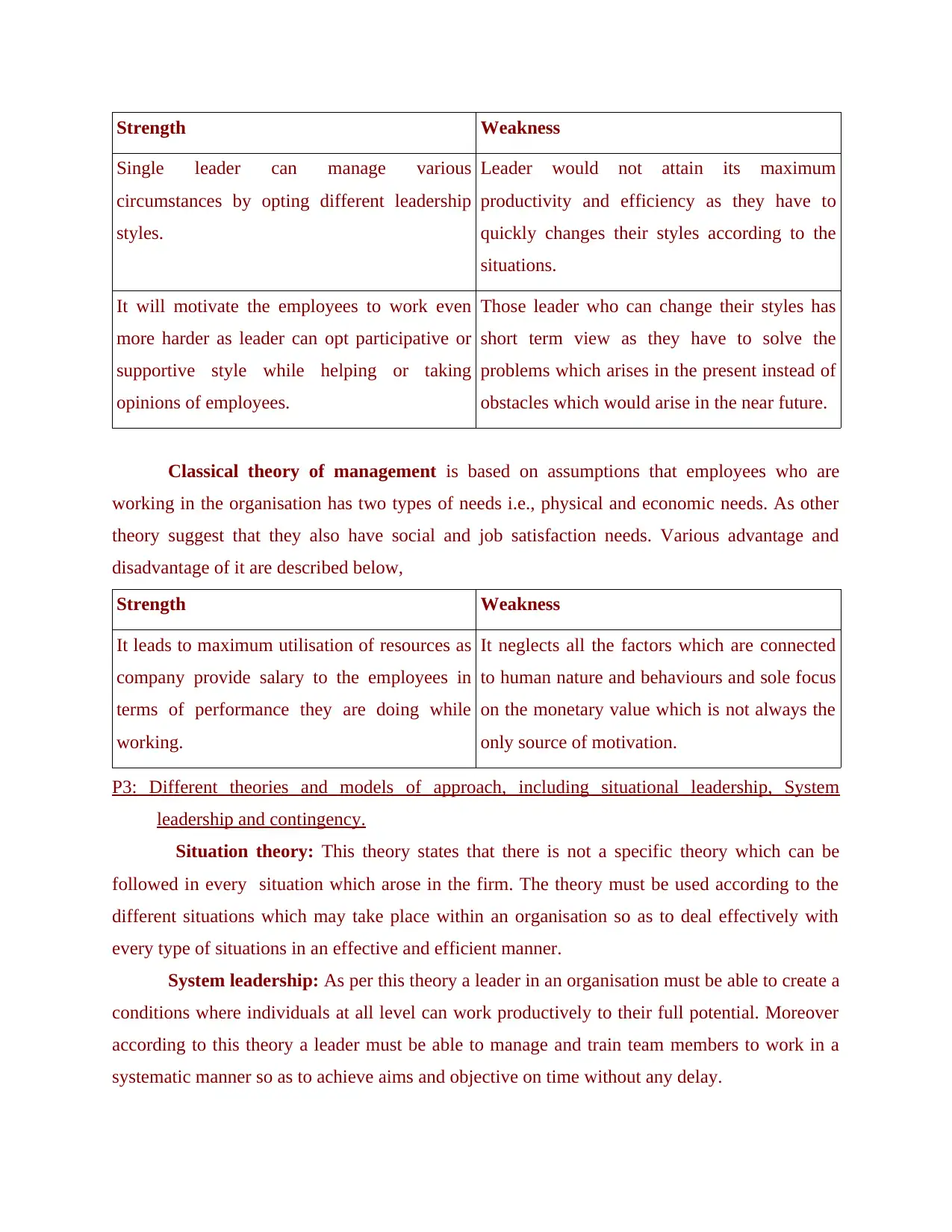
Strength Weakness
Single leader can manage various
circumstances by opting different leadership
styles.
Leader would not attain its maximum
productivity and efficiency as they have to
quickly changes their styles according to the
situations.
It will motivate the employees to work even
more harder as leader can opt participative or
supportive style while helping or taking
opinions of employees.
Those leader who can change their styles has
short term view as they have to solve the
problems which arises in the present instead of
obstacles which would arise in the near future.
Classical theory of management is based on assumptions that employees who are
working in the organisation has two types of needs i.e., physical and economic needs. As other
theory suggest that they also have social and job satisfaction needs. Various advantage and
disadvantage of it are described below,
Strength Weakness
It leads to maximum utilisation of resources as
company provide salary to the employees in
terms of performance they are doing while
working.
It neglects all the factors which are connected
to human nature and behaviours and sole focus
on the monetary value which is not always the
only source of motivation.
P3: Different theories and models of approach, including situational leadership, System
leadership and contingency.
Situation theory: This theory states that there is not a specific theory which can be
followed in every situation which arose in the firm. The theory must be used according to the
different situations which may take place within an organisation so as to deal effectively with
every type of situations in an effective and efficient manner.
System leadership: As per this theory a leader in an organisation must be able to create a
conditions where individuals at all level can work productively to their full potential. Moreover
according to this theory a leader must be able to manage and train team members to work in a
systematic manner so as to achieve aims and objective on time without any delay.
Single leader can manage various
circumstances by opting different leadership
styles.
Leader would not attain its maximum
productivity and efficiency as they have to
quickly changes their styles according to the
situations.
It will motivate the employees to work even
more harder as leader can opt participative or
supportive style while helping or taking
opinions of employees.
Those leader who can change their styles has
short term view as they have to solve the
problems which arises in the present instead of
obstacles which would arise in the near future.
Classical theory of management is based on assumptions that employees who are
working in the organisation has two types of needs i.e., physical and economic needs. As other
theory suggest that they also have social and job satisfaction needs. Various advantage and
disadvantage of it are described below,
Strength Weakness
It leads to maximum utilisation of resources as
company provide salary to the employees in
terms of performance they are doing while
working.
It neglects all the factors which are connected
to human nature and behaviours and sole focus
on the monetary value which is not always the
only source of motivation.
P3: Different theories and models of approach, including situational leadership, System
leadership and contingency.
Situation theory: This theory states that there is not a specific theory which can be
followed in every situation which arose in the firm. The theory must be used according to the
different situations which may take place within an organisation so as to deal effectively with
every type of situations in an effective and efficient manner.
System leadership: As per this theory a leader in an organisation must be able to create a
conditions where individuals at all level can work productively to their full potential. Moreover
according to this theory a leader must be able to manage and train team members to work in a
systematic manner so as to achieve aims and objective on time without any delay.
⊘ This is a preview!⊘
Do you want full access?
Subscribe today to unlock all pages.

Trusted by 1+ million students worldwide
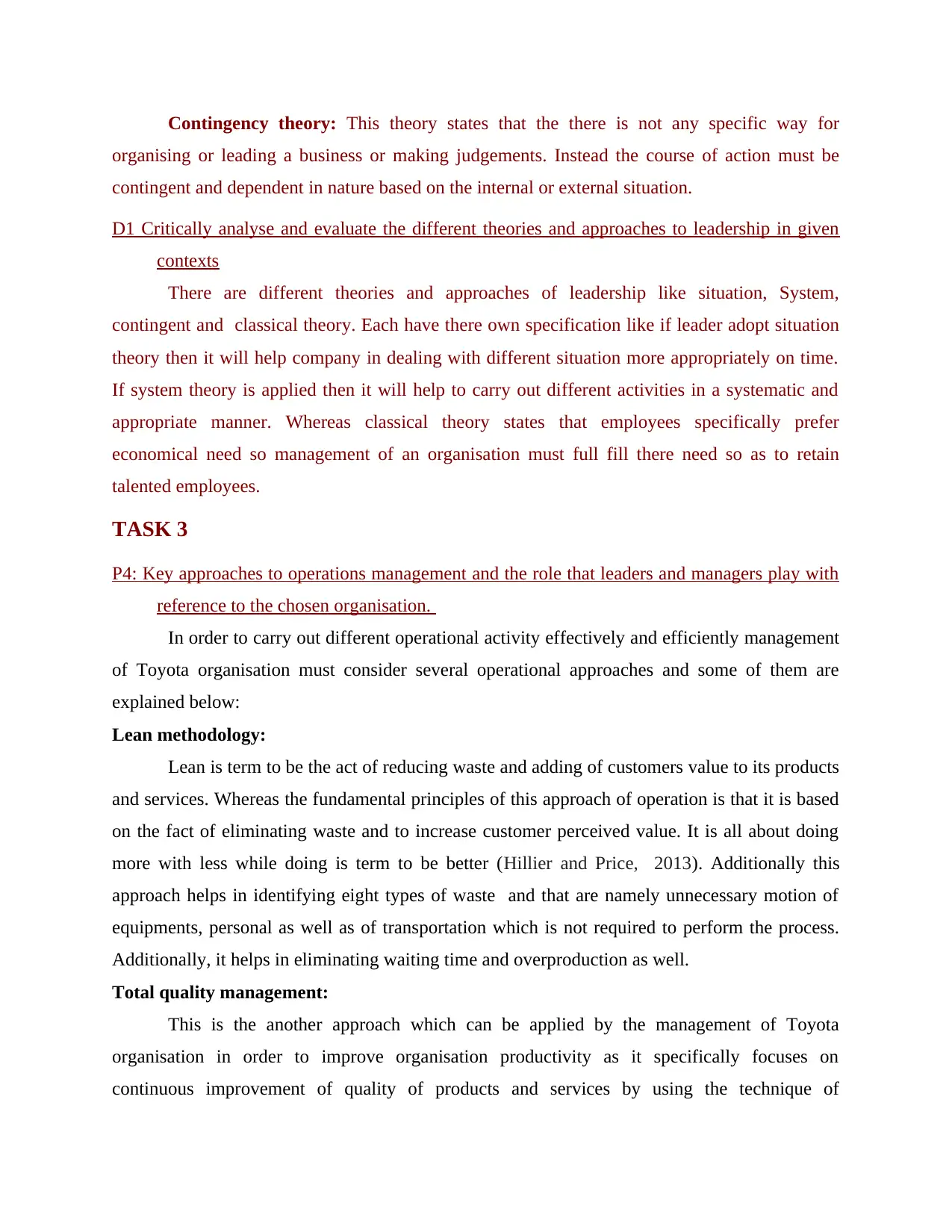
Contingency theory: This theory states that the there is not any specific way for
organising or leading a business or making judgements. Instead the course of action must be
contingent and dependent in nature based on the internal or external situation.
D1 Critically analyse and evaluate the different theories and approaches to leadership in given
contexts
There are different theories and approaches of leadership like situation, System,
contingent and classical theory. Each have there own specification like if leader adopt situation
theory then it will help company in dealing with different situation more appropriately on time.
If system theory is applied then it will help to carry out different activities in a systematic and
appropriate manner. Whereas classical theory states that employees specifically prefer
economical need so management of an organisation must full fill there need so as to retain
talented employees.
TASK 3
P4: Key approaches to operations management and the role that leaders and managers play with
reference to the chosen organisation.
In order to carry out different operational activity effectively and efficiently management
of Toyota organisation must consider several operational approaches and some of them are
explained below:
Lean methodology:
Lean is term to be the act of reducing waste and adding of customers value to its products
and services. Whereas the fundamental principles of this approach of operation is that it is based
on the fact of eliminating waste and to increase customer perceived value. It is all about doing
more with less while doing is term to be better (Hillier and Price, 2013). Additionally this
approach helps in identifying eight types of waste and that are namely unnecessary motion of
equipments, personal as well as of transportation which is not required to perform the process.
Additionally, it helps in eliminating waiting time and overproduction as well.
Total quality management:
This is the another approach which can be applied by the management of Toyota
organisation in order to improve organisation productivity as it specifically focuses on
continuous improvement of quality of products and services by using the technique of
organising or leading a business or making judgements. Instead the course of action must be
contingent and dependent in nature based on the internal or external situation.
D1 Critically analyse and evaluate the different theories and approaches to leadership in given
contexts
There are different theories and approaches of leadership like situation, System,
contingent and classical theory. Each have there own specification like if leader adopt situation
theory then it will help company in dealing with different situation more appropriately on time.
If system theory is applied then it will help to carry out different activities in a systematic and
appropriate manner. Whereas classical theory states that employees specifically prefer
economical need so management of an organisation must full fill there need so as to retain
talented employees.
TASK 3
P4: Key approaches to operations management and the role that leaders and managers play with
reference to the chosen organisation.
In order to carry out different operational activity effectively and efficiently management
of Toyota organisation must consider several operational approaches and some of them are
explained below:
Lean methodology:
Lean is term to be the act of reducing waste and adding of customers value to its products
and services. Whereas the fundamental principles of this approach of operation is that it is based
on the fact of eliminating waste and to increase customer perceived value. It is all about doing
more with less while doing is term to be better (Hillier and Price, 2013). Additionally this
approach helps in identifying eight types of waste and that are namely unnecessary motion of
equipments, personal as well as of transportation which is not required to perform the process.
Additionally, it helps in eliminating waiting time and overproduction as well.
Total quality management:
This is the another approach which can be applied by the management of Toyota
organisation in order to improve organisation productivity as it specifically focuses on
continuous improvement of quality of products and services by using the technique of
Paraphrase This Document
Need a fresh take? Get an instant paraphrase of this document with our AI Paraphraser
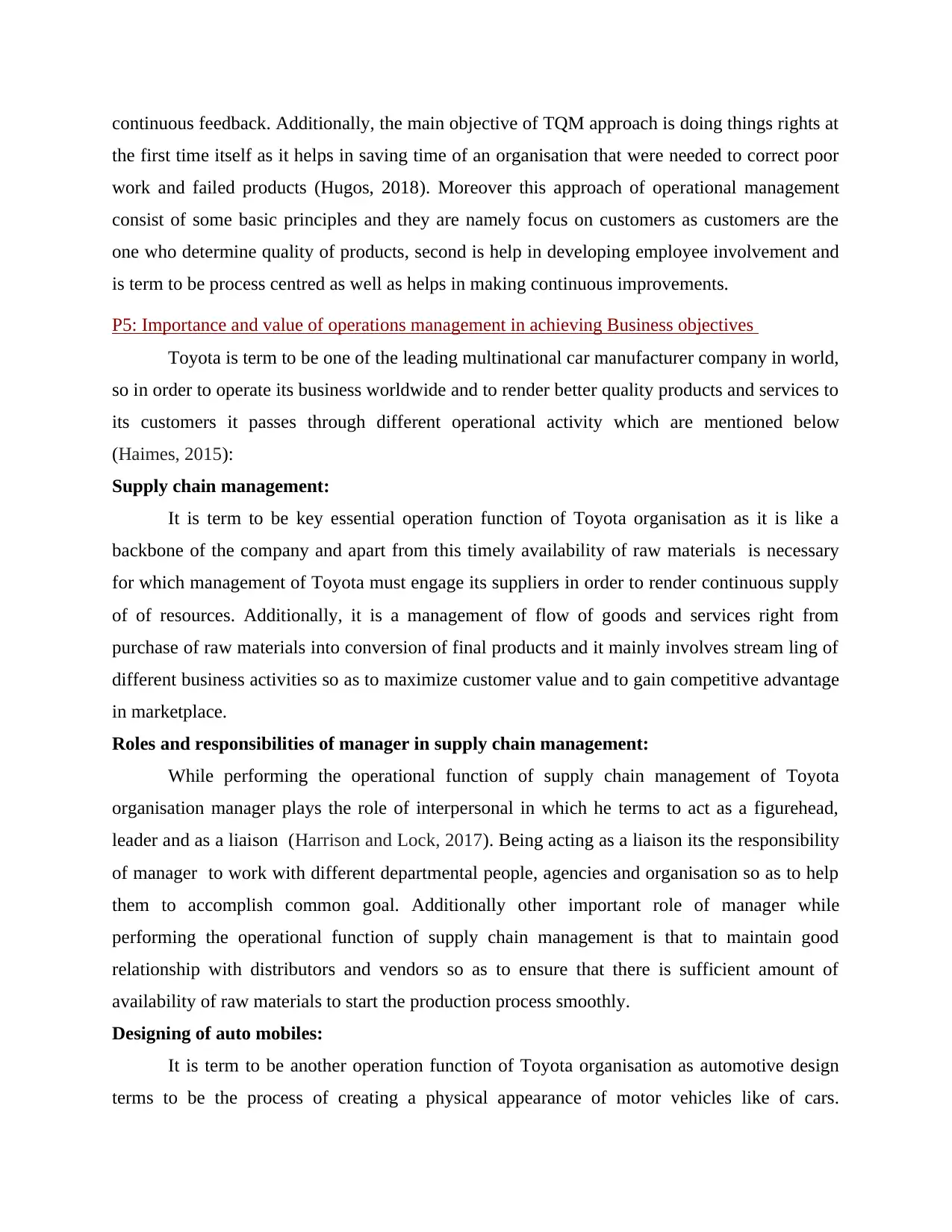
continuous feedback. Additionally, the main objective of TQM approach is doing things rights at
the first time itself as it helps in saving time of an organisation that were needed to correct poor
work and failed products (Hugos, 2018). Moreover this approach of operational management
consist of some basic principles and they are namely focus on customers as customers are the
one who determine quality of products, second is help in developing employee involvement and
is term to be process centred as well as helps in making continuous improvements.
P5: Importance and value of operations management in achieving Business objectives
Toyota is term to be one of the leading multinational car manufacturer company in world,
so in order to operate its business worldwide and to render better quality products and services to
its customers it passes through different operational activity which are mentioned below
(Haimes, 2015):
Supply chain management:
It is term to be key essential operation function of Toyota organisation as it is like a
backbone of the company and apart from this timely availability of raw materials is necessary
for which management of Toyota must engage its suppliers in order to render continuous supply
of of resources. Additionally, it is a management of flow of goods and services right from
purchase of raw materials into conversion of final products and it mainly involves stream ling of
different business activities so as to maximize customer value and to gain competitive advantage
in marketplace.
Roles and responsibilities of manager in supply chain management:
While performing the operational function of supply chain management of Toyota
organisation manager plays the role of interpersonal in which he terms to act as a figurehead,
leader and as a liaison (Harrison and Lock, 2017). Being acting as a liaison its the responsibility
of manager to work with different departmental people, agencies and organisation so as to help
them to accomplish common goal. Additionally other important role of manager while
performing the operational function of supply chain management is that to maintain good
relationship with distributors and vendors so as to ensure that there is sufficient amount of
availability of raw materials to start the production process smoothly.
Designing of auto mobiles:
It is term to be another operation function of Toyota organisation as automotive design
terms to be the process of creating a physical appearance of motor vehicles like of cars.
the first time itself as it helps in saving time of an organisation that were needed to correct poor
work and failed products (Hugos, 2018). Moreover this approach of operational management
consist of some basic principles and they are namely focus on customers as customers are the
one who determine quality of products, second is help in developing employee involvement and
is term to be process centred as well as helps in making continuous improvements.
P5: Importance and value of operations management in achieving Business objectives
Toyota is term to be one of the leading multinational car manufacturer company in world,
so in order to operate its business worldwide and to render better quality products and services to
its customers it passes through different operational activity which are mentioned below
(Haimes, 2015):
Supply chain management:
It is term to be key essential operation function of Toyota organisation as it is like a
backbone of the company and apart from this timely availability of raw materials is necessary
for which management of Toyota must engage its suppliers in order to render continuous supply
of of resources. Additionally, it is a management of flow of goods and services right from
purchase of raw materials into conversion of final products and it mainly involves stream ling of
different business activities so as to maximize customer value and to gain competitive advantage
in marketplace.
Roles and responsibilities of manager in supply chain management:
While performing the operational function of supply chain management of Toyota
organisation manager plays the role of interpersonal in which he terms to act as a figurehead,
leader and as a liaison (Harrison and Lock, 2017). Being acting as a liaison its the responsibility
of manager to work with different departmental people, agencies and organisation so as to help
them to accomplish common goal. Additionally other important role of manager while
performing the operational function of supply chain management is that to maintain good
relationship with distributors and vendors so as to ensure that there is sufficient amount of
availability of raw materials to start the production process smoothly.
Designing of auto mobiles:
It is term to be another operation function of Toyota organisation as automotive design
terms to be the process of creating a physical appearance of motor vehicles like of cars.
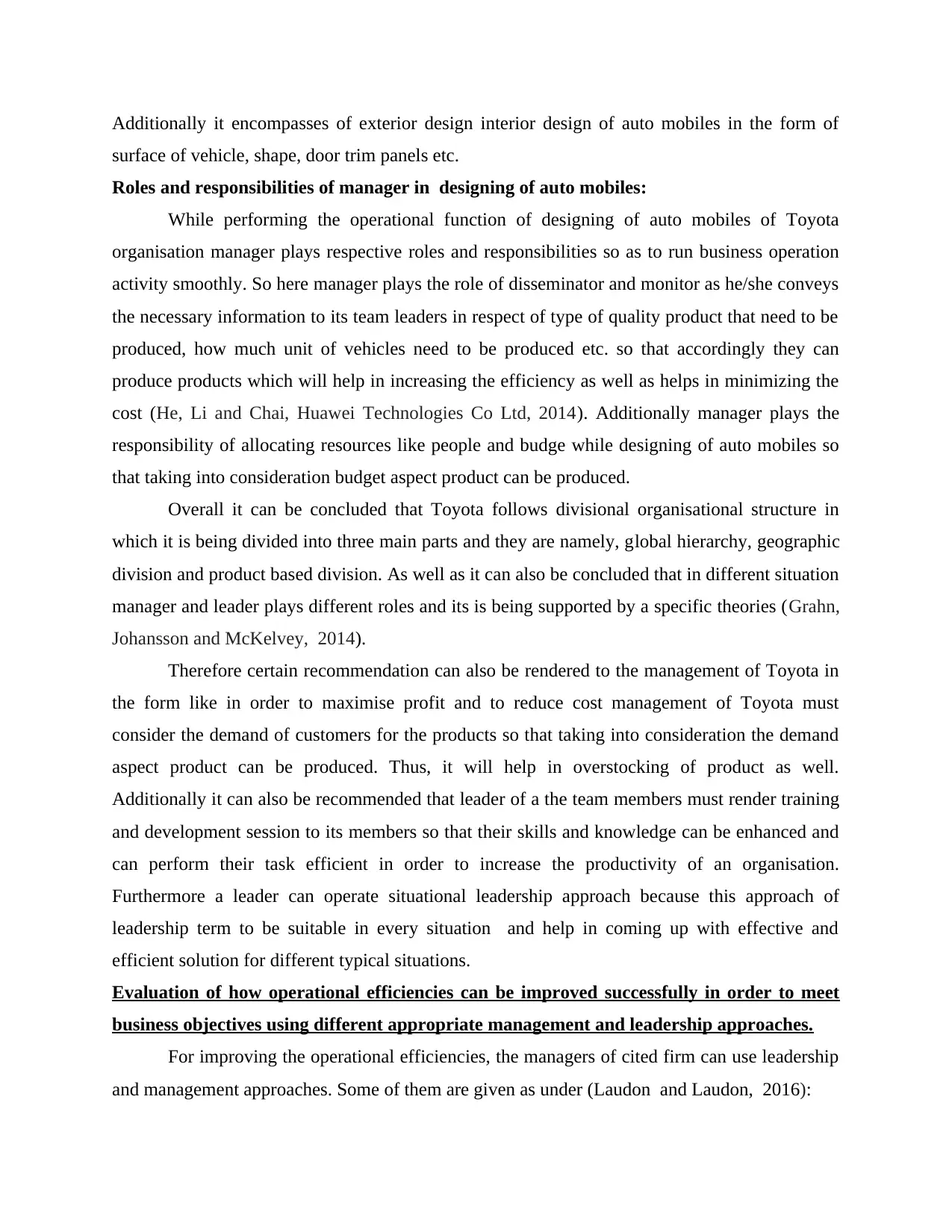
Additionally it encompasses of exterior design interior design of auto mobiles in the form of
surface of vehicle, shape, door trim panels etc.
Roles and responsibilities of manager in designing of auto mobiles:
While performing the operational function of designing of auto mobiles of Toyota
organisation manager plays respective roles and responsibilities so as to run business operation
activity smoothly. So here manager plays the role of disseminator and monitor as he/she conveys
the necessary information to its team leaders in respect of type of quality product that need to be
produced, how much unit of vehicles need to be produced etc. so that accordingly they can
produce products which will help in increasing the efficiency as well as helps in minimizing the
cost (He, Li and Chai, Huawei Technologies Co Ltd, 2014). Additionally manager plays the
responsibility of allocating resources like people and budge while designing of auto mobiles so
that taking into consideration budget aspect product can be produced.
Overall it can be concluded that Toyota follows divisional organisational structure in
which it is being divided into three main parts and they are namely, global hierarchy, geographic
division and product based division. As well as it can also be concluded that in different situation
manager and leader plays different roles and its is being supported by a specific theories (Grahn,
Johansson and McKelvey, 2014).
Therefore certain recommendation can also be rendered to the management of Toyota in
the form like in order to maximise profit and to reduce cost management of Toyota must
consider the demand of customers for the products so that taking into consideration the demand
aspect product can be produced. Thus, it will help in overstocking of product as well.
Additionally it can also be recommended that leader of a the team members must render training
and development session to its members so that their skills and knowledge can be enhanced and
can perform their task efficient in order to increase the productivity of an organisation.
Furthermore a leader can operate situational leadership approach because this approach of
leadership term to be suitable in every situation and help in coming up with effective and
efficient solution for different typical situations.
Evaluation of how operational efficiencies can be improved successfully in order to meet
business objectives using different appropriate management and leadership approaches.
For improving the operational efficiencies, the managers of cited firm can use leadership
and management approaches. Some of them are given as under (Laudon and Laudon, 2016):
surface of vehicle, shape, door trim panels etc.
Roles and responsibilities of manager in designing of auto mobiles:
While performing the operational function of designing of auto mobiles of Toyota
organisation manager plays respective roles and responsibilities so as to run business operation
activity smoothly. So here manager plays the role of disseminator and monitor as he/she conveys
the necessary information to its team leaders in respect of type of quality product that need to be
produced, how much unit of vehicles need to be produced etc. so that accordingly they can
produce products which will help in increasing the efficiency as well as helps in minimizing the
cost (He, Li and Chai, Huawei Technologies Co Ltd, 2014). Additionally manager plays the
responsibility of allocating resources like people and budge while designing of auto mobiles so
that taking into consideration budget aspect product can be produced.
Overall it can be concluded that Toyota follows divisional organisational structure in
which it is being divided into three main parts and they are namely, global hierarchy, geographic
division and product based division. As well as it can also be concluded that in different situation
manager and leader plays different roles and its is being supported by a specific theories (Grahn,
Johansson and McKelvey, 2014).
Therefore certain recommendation can also be rendered to the management of Toyota in
the form like in order to maximise profit and to reduce cost management of Toyota must
consider the demand of customers for the products so that taking into consideration the demand
aspect product can be produced. Thus, it will help in overstocking of product as well.
Additionally it can also be recommended that leader of a the team members must render training
and development session to its members so that their skills and knowledge can be enhanced and
can perform their task efficient in order to increase the productivity of an organisation.
Furthermore a leader can operate situational leadership approach because this approach of
leadership term to be suitable in every situation and help in coming up with effective and
efficient solution for different typical situations.
Evaluation of how operational efficiencies can be improved successfully in order to meet
business objectives using different appropriate management and leadership approaches.
For improving the operational efficiencies, the managers of cited firm can use leadership
and management approaches. Some of them are given as under (Laudon and Laudon, 2016):
⊘ This is a preview!⊘
Do you want full access?
Subscribe today to unlock all pages.

Trusted by 1+ million students worldwide
1 out of 17
Related Documents
Your All-in-One AI-Powered Toolkit for Academic Success.
+13062052269
info@desklib.com
Available 24*7 on WhatsApp / Email
![[object Object]](/_next/static/media/star-bottom.7253800d.svg)
Unlock your academic potential
Copyright © 2020–2025 A2Z Services. All Rights Reserved. Developed and managed by ZUCOL.





